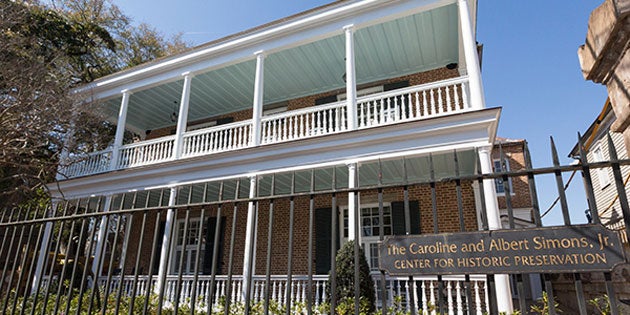
The newly restored exterior of Cameron House, home to the College’s program in historic preservation and community planning.
Sometimes it’s the least expected encounters that make the most difference. And that’s just what happened in the case of the Hugh P. Cameron House, one of the many historic homes on campus and headquarters for the College’s Historic Preservation and Community Planning Program (HPCP).
When President Glenn F. McConnell ’69 took over leadership of the College in July 2014, he briefly lived in the William Blacklock House, right next door to Cameron House. Because McConnell customarily walked across campus to his office, he would occasionally overhear carriage tour drivers stopped in front of the Cameron House snickering about its state of disrepair. That prompted McConnell to take action. He helped pave the way for a near full exterior restoration of the 1851 edifice.
According to Grant Gilmore, who directs the HPCP program, the initial phase of restoration work on the Cameron House was completed last semester. “Prior to that project,” he said, “which lasted the better part of seven months, our building was really in need of triage. Fortunately, the president took a keen interest in it, and it’s now in much better shape.”
Gilmore explained that much of the exterior brickwork was repointed and water damage from leaks was repaired.
“The exterior is now effectively waterproof. That was our primary objective,” said the associate professor. “We replaced rotted exterior wood on the porches and then decked the porches with painted canvas over the decking and copper flashing on the edges. Much of the drainage system was replaced, including gutters, downspouts, etc., and the roof was repaired. We used to have water pool in the cellar, but that no longer happens. We also replaced the drainage pipes all the way to the street. We also replaced or upgraded all of the pattress plates (earthquake plates) on the building.”
Gilmore was keen to add that this renovation was used as a teaching tool for several of the program’s courses. “Students in our building pathology class were able to study the work in progress and those in our building materials conservation course took paint samples to determine which color changes had happened over the years.”
While work at the Cameron House was concluding, two other historic properties that the College owns were honored with Carolopolis Awards from the Preservation Society of Charleston (These awards recognize outstanding achievement in exterior preservation, restoration and rehabilitation.) Both the College Corner (at the intersection of King and George streets) and the Alpha Delta Pi house at 36 Coming St. had undergone significant restorations the previous year.
College Corner received a number of important updates, including having its masonry repointed. These changes helped transform it from a humdrum retail space to an impressive storefront that provides vital exposure for the College on King St.
And 36 Coming St. was structurally stabilized, its non-historic elements (such as a concrete stairway) removed, and the masonry foundation repointed with lime-oyster shell mortar pigmented to match the original color.
Gilmore was pleased that these projects were able to serve as teaching tools for many students. “One student, for example, researched the history of 36 Coming St., and that’s now the only historic study of this building that we have. So these projects have been important sources of hands-on education for students in our program.”
For additional information about Carolopolis Awards, visit the Preservation Society of Charleston.
[owl-carousel category=”Carolopolis” singleItem=”true” paginationNumbers=”true” autoPlay=”false”]






